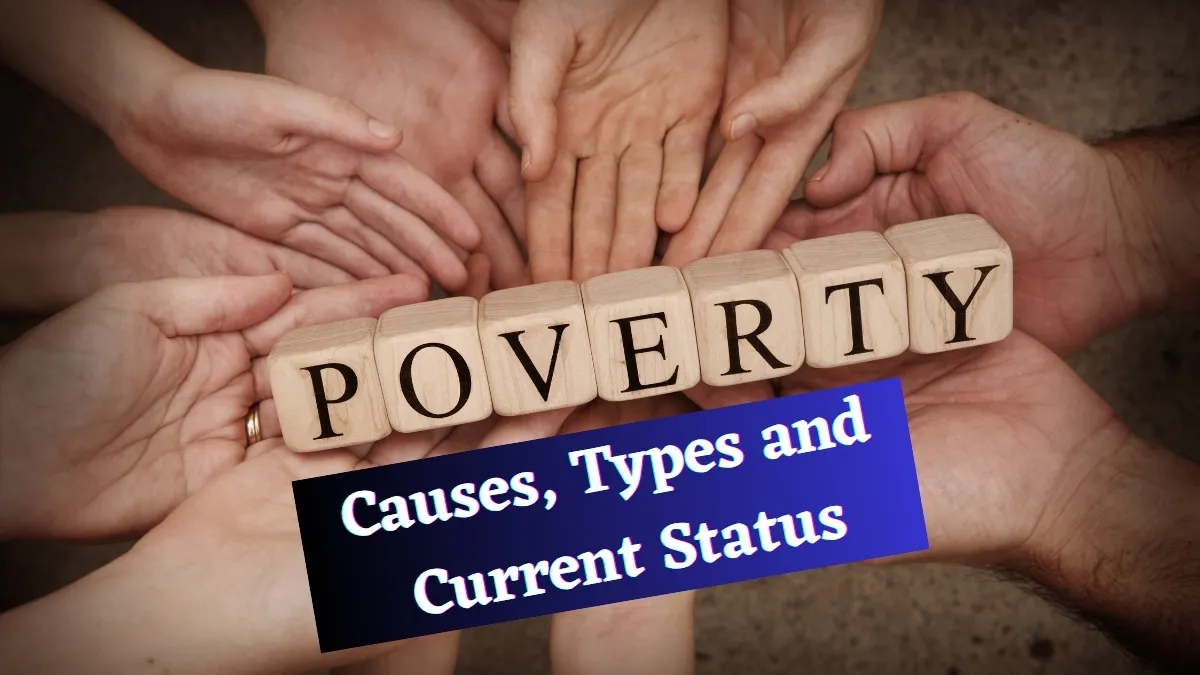Over the several decades in India, India has faced continuous enormous problems of poverty. But in the last 10 years, as per PIB, India has lifted 171 million people out of extreme poverty; according to the World Bank report, the people who are living on less than 2.15 US dollars a day, which is also an international benchmark for extreme poverty, India has just fallen to 2.3% in 2022-2023 from 16.2% in 2011-12. Despite having poverty, India has become the fourth-largest economy in the world, which signifies its lower poverty and good growth in its economy.
In this article, we will explore the poverty in India, its causes, types, and the current status of poverty in India.
What is poverty?
Poverty is a condition in which individuals or communities lack the resources and access for basic necessities which is required for a minimum standard of living. Poverty isn't just about not having enough money. It's also about limited access to crucial things like food, clean water, education, healthcare, a safe place to live, and job opportunities.
What are the causes of poverty in India?
Causes of poverty in India include:
1. Rapid Population Growth:
India has witnessed an enormous rise in population over the past decades. With an average annual growth rate around 2.2% in the past 45 years, nearly 17 million people are added to the Indian population every year. This escalated the demand for food, housing, jobs and other essential resources, putting immense pressure on economic growth.
2. Low Agricultural Output:
Agriculture, the backbone of rural India, suffers from persistently low productivity. Several factors contribute to this, including fragmented landholdings, limited access to modern technology, inadequate capital investment, outdated farming techniques, and substantial losses due to poor storage facilities.
3. Underutilisation of Resources:
India is facing many issues in different regions, like underemployment and disguised unemployment, particularly in the agricultural sector. These conditions will impact the overall poverty, which will reduce both productivity and income levels, thereby impacting the overall quality of life.
4. Slow Economic Growth:
India’s pace of economic development remained sluggish for the first few decades post-independence. Before the economic reforms of 1991, the growth was not strong enough to uplift large sections of society from poverty.
5. Rising Prices:
Consistent inflation has affected the purchasing power of low-income groups. While some benefit from price increases, poor households often struggle to afford even their most basic needs due to rising costs of food, fuel, and essential commodities.
6. High Unemployment Rates:
As the population grows, so does the number of job seekers. However, the economy has not generated sufficient employment opportunities to keep pace, leaving many without work or underemployed.
7. Lack of Capital and Entrepreneurial Support:
Insufficient availability of capital and limited encouragement for entrepreneurship lead to low levels of investment, slowing job creation and economic diversification.
8. Social and Cultural Barriers:
In addition to economic reasons, social structures play a role in perpetuating poverty. Practices such as the caste system, inheritance laws, and rigid traditions often prevent upward mobility, especially in rural areas.
9. Historical Exploitation:
Centuries of colonial rule severely weakened India's economic structure. The British dismantled thriving industries like handicrafts and textiles, turning India into a raw material supplier for European factories, which led to widespread unemployment and poverty.
10. Vulnerability to Natural Disasters:
Several poverty-stricken states like Bihar, Uttar Pradesh, Madhya Pradesh, Chhattisgarh, Odisha, and Jharkhand frequently face natural calamities—floods, droughts, cyclones, and earthquakes—that disrupt agricultural activity and worsen living conditions for millions.
What types of poverty are there in India?
Types of Poverty in India:
-
Absolute Poverty:
Defined by a fixed threshold, such as earning less than $1.90 per day (World Bank standard). Reflects life-threatening deprivation of resources.
-
Relative Poverty:
Based on societal standards, people are considered poor if their income is significantly below the average in their society. Highlights income inequality.
What is the Current Status of Poverty in India?
In 2025, the World Bank released a report, and as per the latest report, India has achieved making the fall of poverty from 16.2% to 2.3%, lifting 171 million people above the poverty line. In India, rural extreme poverty just fell from 18.4% to 2.8% and in urban areas from 10.7% to 1.1%, which makes the narrow gap between the rural and urban poverty status in India. The five most populous states of India, which are UP, Maharashtra, Bihar, West Bengal, and MP, all these five states accounted for 65% of the total India’s extreme poor in 2011-2012, but in 2022-23, these are the only states of India that contributed to two-thirds of the overall decline in poverty.
Source: World Bank
Conclusion
Poverty in India is a real and true issue which is deeply rooted in historical to current situations. It generally makes challenges in economics and social challenges. Poverty arises due to many factors, such as rapid population growth, low agricultural productivity, unemployment and social inequalities. However, in the last 10 years, India has made remarkable progress in reducing falling poverty. According to the World Bank, the percentage of people living on less than $2.15 a day has dropped from 16.2% in 2011–12 to just 2.3% in 2022–23, lifting 171 million people out of extreme poverty. The achievement of India in reducing the poverty level is showing good and prosperous increases in economic growth.
